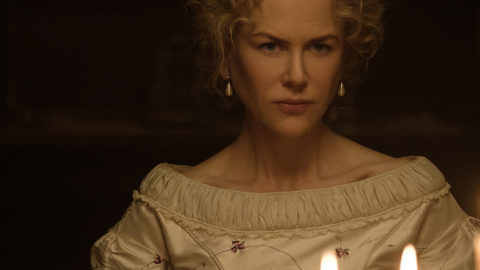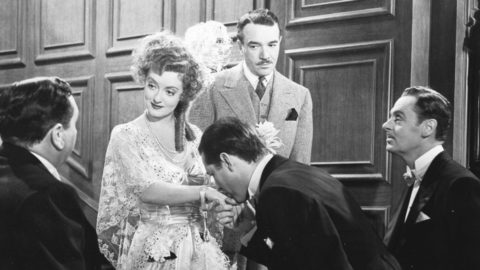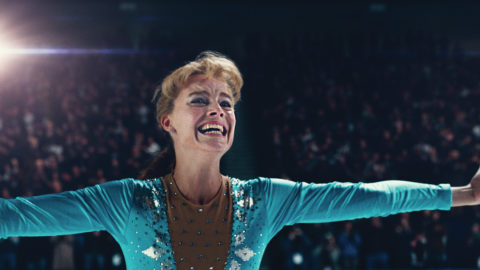Film of the Week: Destroyer

Roland Barthes famously said of two mythical actresses, “Garbo’s face is an Idea, [Audrey] Hepburn’s an Event.” By the same token, you could say that Nicole Kidman’s face is a Gamble, a throw of the dice. You never know what you’re going to get: Kidman gives good performances and bad ones, but she also gives good and bad face. One of the great close-ups in this century’s cinema comes in Jonathan Glazer’s Birth; it holds tight on Kidman’s face as her character sits watching an opera performance, and the slightest tremors (and they are slight, just delicate vibrations) speak volumes. By contrast, the extreme close-ups in the much-derided Grace of Monaco—the camera hovering over the surface of her skin like a reconnaissance drone—tells you only that never in a million years could Kidman plausibly pass for the erstwhile Grace Kelly.
Kidman has made more elusive play on her facial features than most Hollywood actresses. That’s not so much because she transforms it (the preposterous conk of The Hours apart) but because for whatever reasons, natural or artificial, it uncannily resists the normal wear and tear of time. In early screen roles such as Dead Calm and Flirting, she looked unaffected, almost child-like; it served to highlight the sophisticated intelligence of her next phase (The Portrait of a Lady, Eyes Wide Shut), and to make her displays of cartoonish glamour (To Die For, Moulin Rouge) all the more headily artificial. I haven’t seen Kidman’s most prominent recent screen role, HBO series Big Little Lies, but the two recent roles I’ve most enjoyed her in have seen Kidman embracing a more earthy humanity that she’s sometimes seemed to hold off, as well as fully playing her age. In Yorgos Lanthimos’s The Killing of a Scared Deer, you believe her weary suburban despair, like someone who’s lived a comfortable life too long and has been slowly eaten alive by it; while her eccentric support role in Campion’s Top of the Lake: China Girl, a character seemingly older than her own 51 years, exuded haughty, patrician knowingness.
A film like Karyn Kusama’s Destroyer clearly offers the kind of role that actresses embrace when they want to show that they can abandon glamour for harsh realism, or that they’re ready to move into the Streep bracket. This is often done by getting ugly, or just a little lived-in: Charlize Theron famously made a successful bid for such prestige in Monster. I just wished the trick paid off as well for Kidman here: unfortunately, neither the performance nor the film quite convinces.
You know what kind of stakes ride on her characterization when we first see Kidman in close-up peering groggily into bright daylight, with red eyes that look as if her character has either suffered lifelong grief, or just contracted a nasty touch of conjunctivitis. Waking up in her car under a bridge, LAPD detective Erin Bell slouches wearily down to a nearby riverbank where her colleagues are inspecting a dead body. “You’re dragging anchor,” one tells her, observing her gait; she’s dragging diction too, addressing them in a slurred, not-really-there voice that just about rises from the depths of its own well. She scans some details of the scene (black dots tattooed on the victim’s neck, gun by his side, purple marks on a banknote under him), announces wearily that she might know who the perp is, and schleps off on her solitary rounds.
Next, we see Bell at her precinct, where she’s received another purple-stained banknote in the post. This notifies her that someone called Silas is back. Back from where? From her own murky past, of course. She sets out to find him, via a chain of his associates. One is the severely injured Toby (James Jordan), immobilized at home in bed; she gets the info she needs by grimly jerking him off. Another is Arturo (Zach Villa), whom she finds at a Latino church; he’s a counselor now, in suit and tie, but years before, he was a feral cool cat with a mean floppy forelock.
Next comes sleazy, moneyed bagman named DiFranco, played in the film’s ripest, most enjoyable turn by Bradley Whitford—sneery, faintly camp and with a wild shock of white hair. Then there’s the erstwhile Bonnie to Silas’s Clyde—Petra (Orphan Black’s Tatiana Maslany), now in such a state of haggard disrepair that she momentarily makes even the blasted Kidman seem as if she’s just arrived from her last Vogue cover shoot.
Throughout, the narrative zigzags between past and present to gradually piece together Erin’s history: as a young, inexperienced cop years earlier, she was teamed with an officer named Chris (Sebastian Stan) to go undercover and infiltrate the inner circle of Silas (Toby Kebbell), a charismatic, dangerously insightful evil guru to his gang. The first time we see her and Chris, they’re going over the details of how they met and became lovers: in fact, they’re rehearsing their back story to make themselves plausible, but it’s clear that there’s chemistry between them. They kiss, because at some point they’ll have to do it in front of others; after a moment of coolly glowing enthusiasm, it’s clear that, yes, they’ll pass.

It’s clear, however, that something eventually happens to remove Chris from the picture, and that this incident has transformed Erin’s entire life. And not just hers: her inner “taint”—her unexpiated sin, if you want to get theological about it, and the film doesn’t exactly dissuade us—has also affected her teenage daughter Shelby (Jade Pettyjohn), who’s rebelling by dating an older sleazebag. If Erin can rescue Shelby, we understand, she can perhaps ensure her own redemption.
Destroyer is constructed with some ingenuity by the film’s screenwriters and producers Phil Hay and Matt Manfredi. The duo must have felt they needed to tackle something darker and weightier after writing the likes of Clash of the Titans, R.I.P.D., and Ice Cube/Kevin Hart lark Ride Along. You could say they’re over-compensating here: Destroyer is so dark and portentous, it’s almost as if they were making amends for inventing the Care Bears.
One would guess that among the major inspirations for this film are the moody, unapologetically pessimistic American thrillers of the 1970s—Night Moves, The Long Goodbye, et al.—with perhaps a nod to the late Nicolas Roeg in the general fractured shape of things. There’s definitely a feel of ’70s crime to some of the supporting character turns, Whitford’s especially. But overall, something doesn’t gel, and while the film looks and feels stylish and distinctive—Julie Kirkwood’s atmospherically downbeat city photography, Theodore Shapiro’s stark, ominous string score—the film seems too much in thrall to its overcast mood, bringing home the point that its characters are living in an earthly hell. L.A. and its environs appear cloaked in metallic grey skies, the inner landscape of Erin’s soul. In the end, what the film reminded me most of all was 21 Grams, a film that wore its damnation-and-redemption themes a little too plainly on its sleeve—as, we eventually realize, this does too.
Karyn Kusama has been mainly active in TV for a while—Halt and Catch Fire, The Man in the High Castle. But as a cinema director, she’s known for films that put tough, not to say dangerous women stage center—realist debut Girlfight (which introduced Michelle Rodriguez) and genre pieces Jennifer’s Body (written by Diablo Cody) and Aeon Flux (written, like Kusama’s 2015 chiller The Invitation, by Hay and Manfredi).
Destroyer must stand or fall on Kidman’s performance, but it doesn’t really convince. One of the striking things here is Kidman’s ability to be Erin at two different periods of her life. She seems very comfortable playing her as an apparent ingénue, fresh-faced and up for anything—adventure, challenge, transgression—with what emerges as a potent streak of recklessness. The later Erin, some 15 years older, is outwardly a broken woman, as witness her ashen features, her slouching sleepwalker’s gait, and the scuffed carapace of a leather jacket. Her skin’s pretty rough too—to quote a magnificent idiom (Scottish, I think), she’s ‘seen a few frosty mornings’. Yet Kidman, as the older Erin, still seems unsettlingly youthful despite the signs of inner and outer damage: alert, hyper-conscious eyes peer out through the appearance of sluggishness. The most striking sign of her heavy weathering is an oddly soiled face, as if she’s had grit or a dab of machine oil rubbed into her pores. Given how young she still seems, it’s the gamine-gone-grubby look.
Kidman can be effortlessly confident and casual when she wants, as witness Top of the Lake: China Girl—but here she feels constrained. She seems to be aware that as much is riding on her performance as there is riding emotionally and existentially on Erin herself. Too often Kusama shows Erin hunched stiffly at the wheel of her car, staring ahead with deathly intent. We get too much of the glare of steely determination, and too much of the dead grey drone of her voice. By contrast, when the younger Erin flirts knowingly with Chris, or suggests something shockingly transgressive to him, it’s something we’ve seen Kidman do before, but it breathes, it’s really her. The older Erin feels like a Halloween disguise she’s wearing; given that the film is predicated on the shock of what you didn’t know Kidman can do, that’s a major flaw. The portentously contrived twist ending is another problem but still, if you’d been through what Erin has by this point, you’d be red-eyed too.
Jonathan Romney is a contributing editor to Film Comment and writes its Film of the Week column. He is a member of the London Film Critics Circle.







